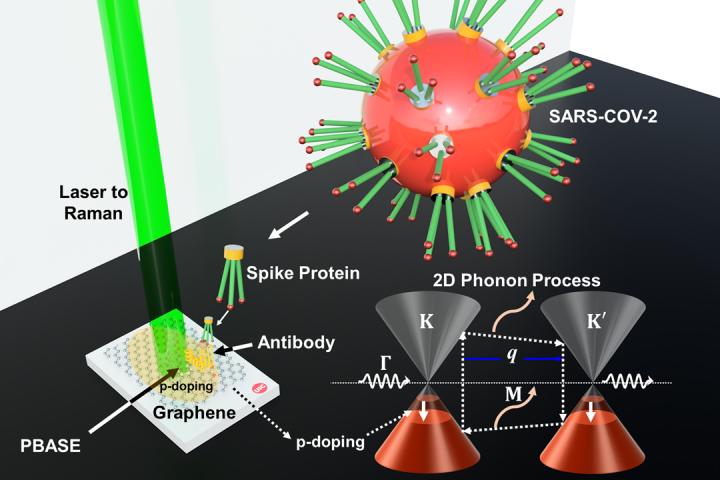‘Wonder material’ can be used to detect COVID-19 quickly, accurately

An illustration of the graphene-based COVID-19 spike protein detection process developed at UIC. The white rectangle represents the substrate with graphene functionalized with SARS-CoV-2 antibody (shown in yellow). When this graphene detector interacts with the virus' spike protein in a COVID-positive sample, its atomic vibration frequency changes.
Credit: Vikas Berry
Researchers show a graphene-based sensor can detect SARS-CoV-2.
Researchers at the University of Illinois Chicago have successfully used graphene — one of the strongest, thinnest known materials — to detect the SARS-CoV-2 virus in laboratory experiments. The researchers say the discovery could be a breakthrough in coronavirus detection, with potential applications in the fight against COVID-19 and its variants.
In experiments, researchers combined sheets of graphene, which are more than 1,000 times thinner than a postage stamp, with an antibody designed to target the infamous spike protein on the coronavirus. They then measured the atomic-level vibrations of these graphene sheets when exposed to COVID-positive and COVID-negative samples in artificial saliva. These sheets were also tested in the presence of other coronaviruses, like Middle East respiratory syndrome, or MERS-CoV.
The UIC researchers found that the vibrations of the antibody-coupled graphene sheet changed when treated with a COVID-positive sample, but not when treated with a COVID-negative sample or with other coronaviruses. Vibrational changes, measured with a device called a Raman spectrometer, were evident in under five minutes.
Their findings are published in the journal ACS Nano.
“We have been developing graphene sensors for many years. In the past, we have built detectors for cancer cells and ALS. It is hard to imagine a more pressing application than to help stem the spread of the current pandemic,” said Vikas Berry, professor and head of chemical engineering at the UIC College of Engineering and senior author of the paper. “There is a clear need in society for better ways to quickly and accurately detect COVID and its variants, and this research has the potential to make a real difference. The modified sensor is highly sensitive and selective for COVID, and it is fast and inexpensive.”
“This project has been an amazingly novel response to the need and demand for detection of viruses, quickly and accurately,” said study co-author Garrett Lindemann, a researcher with Carbon Advanced Materials and Products, or CAMP. “The development of this technology as a clinical testing device has many advantages over the currently deployed and used tests.”
Berry says that graphene — which has been called a “wonder material” — has unique properties that make it highly versatile, making this type of sensor possible.
Graphene is a single-atom-thick material made up of carbon. Carbon atoms are bound by chemical bonds whose elasticity and movement can produce resonant vibrations, also known as phonons, which can be very accurately measured. When a molecule like a SARS-CoV-2 molecule interacts with graphene, it changes these resonant vibrations in a very specific and quantifiable way.
“Graphene is just one atom thick, so a molecule on its surface is relatively enormous and can produce a specific change in its electronic energy,” Berry said. “In this experiment, we modified graphene with an antibody and, in essence, calibrated it to react only with the SARS-CoV-2 spike protein. Using this method, graphene could similarly be used to detect COVID-19 variants.”
###
The researchers say the potential applications for a graphene atomic-level sensor — from detecting COVID to ALS to cancer — continue to expand.
A provisional patent has been submitted based on this work.
Additional co-authors of the paper include Ngoc Hoang Lan Nguyen and Sungjoon Kim of UIC. The work has been funded by Ramaco Carbon and their affiliate CAMP, and partly by the Office of Naval Research.
All latest news from the category: Medical Engineering
The development of medical equipment, products and technical procedures is characterized by high research and development costs in a variety of fields related to the study of human medicine.
innovations-report provides informative and stimulating reports and articles on topics ranging from imaging processes, cell and tissue techniques, optical techniques, implants, orthopedic aids, clinical and medical office equipment, dialysis systems and x-ray/radiation monitoring devices to endoscopy, ultrasound, surgical techniques, and dental materials.
Newest articles

A universal framework for spatial biology
SpatialData is a freely accessible tool to unify and integrate data from different omics technologies accounting for spatial information, which can provide holistic insights into health and disease. Biological processes…

How complex biological processes arise
A $20 million grant from the U.S. National Science Foundation (NSF) will support the establishment and operation of the National Synthesis Center for Emergence in the Molecular and Cellular Sciences (NCEMS) at…

Airborne single-photon lidar system achieves high-resolution 3D imaging
Compact, low-power system opens doors for photon-efficient drone and satellite-based environmental monitoring and mapping. Researchers have developed a compact and lightweight single-photon airborne lidar system that can acquire high-resolution 3D…





















